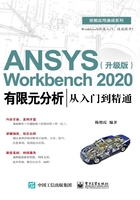
2.2 几何建模实例
在初步了解了DesignModeler的基本功能后,下面通过两个实例来巩固一下建模的操作步骤。
2.2.1 几何建模实例1——实体建模
首先利用Creo(Pro/E)软件加载一个几何数据文件,然后通过集成在Creo(Pro/E)软件上的Workbench菜单将几何文件导入DesignModeler,并在DesignModeler中进行去材料操作,具体操作过程如下。
Step1:打开Creo Parametric程序,在工具栏上单击“打开”按钮,在弹出的“文件打开”对话框中选择banjian1.prt文件,如图2-79所示,此时在下面的预览区域会出现几何文件图形,单击“打开”按钮。
Step2:读入几何文件后的模型如图2-80所示。

图2-79 文件读入

图2-80 模型
Step3:如图2-81所示,选择“开始”→“所有程序”→“ANSYS 2020 R1”→“Workbench 2020 R1”命令,此时开始加载ANSYS Workbench软件。
Step4:在数据加载成功后,程序将在Workbench主界面上自动创建项目A,如图2-82所示。

图2-81 加载ANSYS Workbench软件

图2-82 创建项目A
Step5:双击项目A中A2栏的Geometry选项,此时会加载DesignModeler几何建模平台,如图2-83所示,设置单位为m,此时会在Tree Outline的A:Geometry命令下出现一个![]() 命令。
命令。
Step6:单击常用命令栏中的![]() 按钮,生成几何图形,如图2-84所示。
按钮,生成几何图形,如图2-84所示。

图2-83 DesignModeler几何建模平台

图2-84 DesignModeler中的几何图形1
Step7:单击要进行操作的平面,此平面位于Z轴最大位置,如图2-85所示,单击![]() 按钮,并单击Tree Outline下面的Sketching按钮,切换到Sketching(草绘)模块。
按钮,并单击Tree Outline下面的Sketching按钮,切换到Sketching(草绘)模块。
Step8:在Sketching Toolboxes(草绘工具箱)中选择Draw→Rectangle(矩形)命令并勾选后面的![]() 复选框,表示创建的矩形带倒角。在DesignModeler的绘图窗格中绘制矩形,如图2-86所示。
复选框,表示创建的矩形带倒角。在DesignModeler的绘图窗格中绘制矩形,如图2-86所示。

图2-85 要进行操作的平面

图2-86 DesignModeler中的几何图形2
Step9:选择Dimensions→Radius命令,并选择矩形的一个倒角圆弧,单击鼠标左键确定,如图2-87所示,此时会在圆弧上标注出R1。
Step10:选择Dimensions→Horizontal命令,标注如图2-88所示的水平尺寸。使用同样的操作,选择Dimensions→Vertical命令,标注垂直尺寸。

图2-87 标注半径

图2-88 标注水平尺寸
Step11:如图2-89所示,在Details View面板的Dimensions:5下更改以下参数。
①在H2栏中输入0.06m;在H3栏中输入0.045m。
②在R1栏中输入0.01m。
③在V4栏中输入0.05m;在V5栏中输入0.025m。
其余选项的设置保持默认即可。

图2-89 修改标注
Step12:如图2-90所示,在菜单栏中选择Tools→Unfreeze命令,对导入的模型解除冻结,以便后续的操作。
如图2-91所示,选择Unfreeze1命令,通过Details of Unfreeze1下的Bodies栏选择BANJINAN零件体。
Step13:如图2-92所示,单击常用命令栏中的![]() 按钮,在Details View面板中进行如下修改。
按钮,在Details View面板中进行如下修改。
①在Operation栏中选择Cut Material选项,默认为Add Material。
②在Direction栏中选择Reversed选项,表示拉伸方向为默认的反方向。
③在FD1,Depth(>0)栏中输入0.02m,其余选项的设置保持默认即可。
Step14:单击常用命令栏中的![]() 按钮,生成去材料特征,如图2-93所示。
按钮,生成去材料特征,如图2-93所示。

图2-90 解除冻结

图2-91 Unfreeze设置

图2-92 设置Details of Extrude1

图2-93 去材料特征
Step15:单击常用命令栏中的![]() 按钮,并选择
按钮,并选择![]() 命令,会在Tree Outline(模型树)中出现
命令,会在Tree Outline(模型树)中出现![]() 命令。
命令。
Step16:如图2-94所示,在Details View面板中进行如下修改。
①在FD1,Radius(>0)栏中输入0.02m。
②选择模型的4条边,并在Geometry栏中确定这4个边界被选中。生成的圆角特征如图2-95所示。
Step17:单击工具栏中的![]() 按钮,在弹出的“另存为”对话框的“文件名”文本框中输入plate1.wbpj,单击“保存”按钮,保存文件。
按钮,在弹出的“另存为”对话框的“文件名”文本框中输入plate1.wbpj,单击“保存”按钮,保存文件。
Step18:关闭DesignModeler程序。单击界面右上角的![]() 按钮,关闭DesignModeler程序。
按钮,关闭DesignModeler程序。

图2-94 倒圆角操作

图2-95 圆角特征
2.2.2 几何建模实例2——概念建模
概念建模(Concept)主要用于创建和修改模型中的线或面,使之成为有限元中的梁单元(Beam)或壳单元(Shell)。从Concept菜单(见图2-20)可知,生成梁模型的方法有4种,即Lines From Points(点生成线)、Lines From Sketches(草绘生成线)、Lines From Edges(边线生成线)、3D Curve(从3D曲线生成线);生成面的方法有2种,即Surfaces From Edges(边线生成面)、Surfaces From Sketches(草绘生成面)。
此外,Concept菜单中还有一些常见的截面形状和用户自定义截面形状,如长方形、圆形、空心圆形等。
下面通过一个实例来简要介绍概念建模的过程和截面属性赋予方法,实例模型如图2-96所示。
Step1:新建一个项目A,然后右击项目A中A2栏的Geometry选项,从弹出的快捷菜单中选择New DesignModeler Geometry命令,如图2-97所示。

图2-96 实例模型

图2-97 选择New DesignModeler Geometry命令
Step2:启动DesignModeler平台,选择Units→Millimeter命令,设置单位为mm,如图2-98所示。
Step3:选择Tree Outline→A:Geometry→ZXPlane命令,如图2-99所示,然后单击![]() 按钮。
按钮。

图2-98 设置单位

图2-99 草绘平面
Step4:在切换到Sketching(草绘)模块后,选择Draw→Line命令,在绘图窗格中绘制如图2-100所示的图形。

图2-100 草绘图形
Step5:如图2-101所示,选择Constraints→Parallel命令,然后单击图形右下角的两条水平线段,使它们被约束为平行。

图2-101 平行约束
Step6:如图2-102所示,选择Constraints→Equal Length命令,然后单击图形的各条线,使各条边的长度被约束为相等。

图2-102 边长相等约束
Step7:如图2-103所示,选择Dimensions→General命令,然后单击图形的任何一条线段,标注其长度,在Details View面板的Dimensions:6→H1栏中输入15mm,并按Enter键确定。将H5标为45mm,其余尺寸标为等间距15mm。

图2-103 标注线段长度
Step8:切换到Modeling(实体模型)模块,选择Concept→Lines From Sketches(草绘生成线)命令,如图2-104所示。在Details View面板的Details of Line1→Base Objects栏中选择刚刚草绘的图形,然后单击Apply按钮确定选择。

图2-104 选择Lines From Sketches命令
Step9:单击常用命令栏中的![]() 按钮,生成线体模型,如图2-105所示。
按钮,生成线体模型,如图2-105所示。
Step10:选择![]() 下面的Line Body命令,在下面出现的Details View面板中的Cross Section栏为黄色,其中内容为Not Selected,表示截面特性未被赋予,如图2-106所示。
下面的Line Body命令,在下面出现的Details View面板中的Cross Section栏为黄色,其中内容为Not Selected,表示截面特性未被赋予,如图2-106所示。

图2-105 线体模型

图2-106 未赋予截面特性
Step11:选择Concept→Cross Section→Rectangular命令,在Details View面板的Dimensions:2→B栏中输入2mm,在H栏中输入2mm,并按Enter键确定输入,如图2-107所示。
Step12:选择Line Body命令,在Details View面板的Cross Section栏中选择Rect1选项,如图2-108所示。

图2-107 定义截面特性

图2-108 赋予截面特性
Step13:显示图形截面。选择View→Cross Section Solids命令,如图2-109所示。此时,Cross Section Solids子菜单前面会出现一个√,表示子菜单被选中,同时显示图形截面,如图2-110所示。

图2-109 选择Cross Section Solids命令

图2-110 显示图形截面
Step14:创建壳模型。如图2-111所示,选择Concept→Surfaces From Edges(边线生成曲面)命令。
Step15:选择Tree Outline(模型树)中的Surf1命令,选择绘图窗格中的4条边线,如图2-112所示。在Details View面板的Edges栏中单击Apply按钮,并单击常用命令栏中的![]() 按钮,生成壳模型。
按钮,生成壳模型。

图2-111 选择Surfaces From Edges命令

图2-112 边线生成曲面
Step16:以同样方法完成其余5个区域的曲面设置,结果如图2-113所示。
Step17:单击工具栏中的![]() 按钮,在弹出的“另存为”对话框的“文件名”文本框中输入Concept1.wbpj,如图2-114所示,单击“保存”按钮,保存文件。
按钮,在弹出的“另存为”对话框的“文件名”文本框中输入Concept1.wbpj,如图2-114所示,单击“保存”按钮,保存文件。
Step18:关闭DesignModeler程序,单击界面右上角的![]() 按钮,关闭DesignModeler程序。
按钮,关闭DesignModeler程序。

图2-113 边线生成曲面的最终结果

图2-114 保存文件